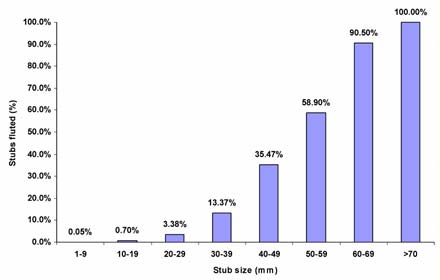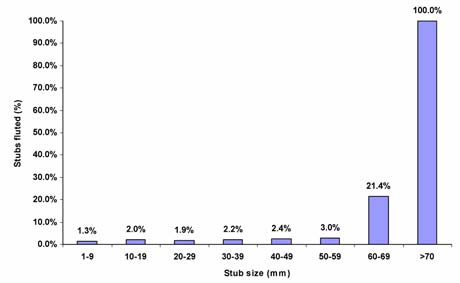PESTS AND DISEASES OF FORESTRY IN NEW ZEALAND
Nectria flute canker – a disease almost beaten?
Scion is the leading provider of forest-related knowledge in New Zealand
Formerly known as the Forest Research Institute, Scion has been a leader in research relating to forest health for over 50 years. The Rotorua-based Crown Research Institute continues to provide science that will protect all forests from damage caused by insect pests, pathogens and weeds. The information presented below arises from these research activities.
From Forest Health News 195, May/June 2009.
When Nectria flute canker was first recognised in New Zealand on Pinus radiata, nothing was known about the disease. The causal agent, Neonectria fuckeliana, was known as a wound invading fungus of Picea and Abies trees growing in the Northern Hemisphere. The fungus was behaving radically differently on a new host in a new environment in a new part of the world (see FH News 180: 1). The pruned stub trial was one of the first trials set up to learn more about what factors influenced Nectria flute canker. It was established in 2003 to to determine the effect of season of pruning on Nectria disease development; to determine the effect of stub treatment with a protective fungicide, and also to determine how long freshly pruned stubs are susceptible to infection. Since 2005, the objective of the trial was broadened to examine the effect of stub size on fluting and to monitor the development of cankers or flutes over time.
Trees were low pruned in 2003 and medium pruned in 2005, both in summer and in winter. After pruning, individual stubs on three whorls per tree were assessed for fluting, initially every 4 months for the first two years after pruning, then twice a year for one year, and then annually until 2007. The final assessment was made in late March 2009. Over 20,000 individual stubs were assessed on each occasion.

After six years, the trial has delivered some significant results. Firstly, we found that pruning or inoculation with N. fuckeliana in winter resulted in a higher incidence of fluting than pruning or inoculation in summer. Secondly, we showed that fungicide applied to stubs was ineffective. However, more importantly, we found that the incidence of fluting is not stable over time. Fluting incidence increased after pruning for about a year, after which it slowly declined over three years, and remained stable after that. That trend was similar after first and second lift pruning operations.
The second significant finding of the trial was that fluting is positively related to stub size. In August 2004, 18 months after summer pruning and one year after winter pruning, fluting was rarely associated with branch stubs smaller than 30 mm in diameter. However, six years after first treatment, almost all the flutes that have persisted are associated with stubs larger than 60 mm.
In October 2007, as part of another study, 30 trees (10 each assessed as having minor, medium, or severe flutes present) were selected for dissection. Very little stained wood was seen on the cut discs except for those taken close to whorls with severe flutes. N. fuckeliana was isolated only from symptomatic wood, never from unstained wood near flutes. These results suggest that many trees with flutes that fully occlude with no outward signs of damage are left with no residual internal damage.

The trial has showed that treatment in winter results in a higher incidence of fluting, as does inoculation with N. fuckeliana. It also showed that many flutes disappear over time and the only trees to show persistent external damage are those with branch stubs over 60 mm in diameter.
From a management perspective, these are important results. Fluting assessments made within four years of pruning need to be treated with caution because it is likely that disease will be overestimated. It appears that only large stubs are associated with disease. Limiting branch stub size to less than 60 mm and avoiding pruning operations in winter should significantly reduce levels of Nectria disease.
This applied research has provided the means to manage Nectria flute canker. The ecology research programme is making good progress in understanding the fundamental processes that produce the results seen in the pruned stub trial.
Lindsay Bulman
This information is intended for general interest only. It is not intended to be a substitute for specific specialist advice on any matter and should not be relied on for that purpose. Scion will not be liable for any direct, indirect, incidental, special, consequential or exemplary damages, loss of profits, or any other intangible losses that result from using the information provided on this site.
(Scion is the trading name of the New Zealand Forest Research Institute Limited.)

 Farm Forestry New Zealand
Farm Forestry New Zealand

